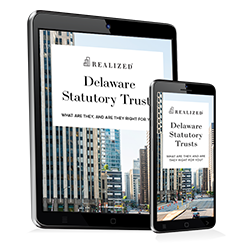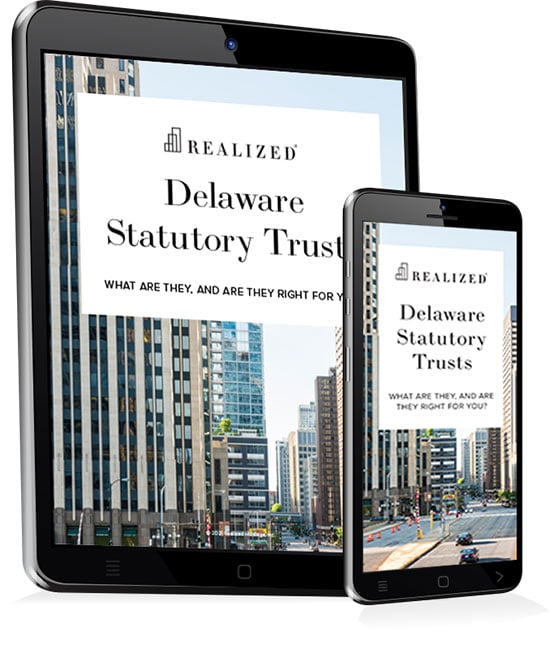
Delaware Statutory Trusts or DSTs are an attractive investment strategy for many investors, offering benefits like passive income, fractional ownership, hands-off involvement, and tax deferral through 1031 Exchanges. Why did it become popular in the first place? Why was the Delaware Statutory Trust formed?
In this blog post, Realized 1031 discusses the relationship between DSTs and 1031 Exchanges and how the DST’s structure made it acceptable for tax deferral in the eyes of the IRS. Let’s dive in.
History of Delaware Statutory Trusts: Why There Was a Need for a Flexible and Secure Investment Structure
Before Delaware Statutory Trusts (DSTs) became widely used, investors seeking to co-invest in real estate often relied on more traditional structures, such as tenant-in-common arrangements or common law trusts. While these structures served their purpose, they could present operational and legal challenges—such as complex management decision-making, less defined liability protection, or more rigid ownership frameworks.
In response to a growing need for a more flexible trust entity, Delaware enacted the Delaware Statutory Trust Act in 1988. This legislation provided a legal framework for a trust that could offer limited liability to investors, more streamlined management, and tax advantages through pass-through treatment. Today, DSTs are commonly used in real estate investment, particularly as replacement properties in 1031 exchanges.
The 1988 Delaware Statutory Trust Act
The Delaware Statutory Trust Act (renamed in 2002) provided a legal framework for a trust-based investment entity that provided flexibility, liability protection, and administrative efficiency. Why the state of Delaware, specifically? Well, Delaware is home to a large number of wealthy families who rely on common law trusts to ensure an easy transfer of generational wealth. Plus, the state has a pro-business legal environment backed by a long history of corporate and trust law expertise.
The DST Act provided verbiage that clarified the permissible activities and structures for DSTs, such as the following.
- Limited Liability for Investors: DSTs protect the investors by separating them from the trust’s debts and obligations. As such, your personal assets are generally protected from lawsuits and financial risk.
- Passive Investment Without Hands-on Management: You enter a DST by buying fractional interests instead of outright owning the property. In this structure, only the DST sponsor can make decisions on management, resulting in a truly passive investment for the investors.
- Pass-Through Tax Treatment: DSTs work like pass-through entities, assigning the tax burden to the investor instead of at the entity level.
Early Applications of DSTs
When the DST Act was enacted in 1988, many investors saw it as a great option for estate planning and investment management. Early adopters used the trust for processes like the following.
Wealth Transfer
During estate planning, DSTs enabled investors to pass assets to heirs without probate. The structure of DSTs separates ownership from control, allowing families to preserve generational wealth under the careful watch of professional asset managers.
Asset Protection
Investors and business owners use DSTs to offer some level of asset protection s from creditors, lawsuits, or financial disputes.
Access to Institutional Grade Investments
DSTs allowed investors to enter high-value assets like institutional-grade real estate. Some DST offerings have relatively low entry thresholds that allow investors to enjoy the benefits of professionally managed, often stabilized, commercial properties — assets that would normally be only available to ultra-high-net-worth individuals. However, these investments are generally illiquid, require accredited investor status, and may carry associated risks.
Emergence of 1031 Exchanges and the Role of DSTs
The applications of DSTs reached new levels upon the approval of IRS Revenue Ruling 2004-86. This ruling allowed investors to exchange proceeds from a 1031 Exchange sale for a fractional interest in a DST, adding tax-deferral of capital gains taxes as another benefit of this investment strategy.
1031 Exchanges are strictly regulated by the IRS. Many rules and stipulations exist to prevent its abuse, such as the 180-day time frame and the like-kind requirement. One cornerstone rule is that you can only exchange real property — no stocks, shares, or other types of assets. However, DSTs were in a gray area. It wasn’t clear whether DSTs count as partnerships, trusts, or business entities. So even though DSTs were attractive to 1031 Exchange investors, there was ambiguity about whether or not they qualified as “real property.”
Revenue Ruling 2004-86 provided definitive language that allowed 1031 Exchange proceeds to be swapped for fractional interest in a DST, even though the latter isn’t technically real property. As long as the DST follows rules like absolute passive ownership and avoids the “seven deadly sins,” then the tax deferral benefits will be applicable. As such, this IRS ruling revolutionized the real estate investment landscape, making DSTs a popular option for 1031 Exchange investors seeking both tax deferral and hassle-free ownership.
Wrapping Up: History of DSTs
DSTs have a fascinating history, being initially used to address the legal and financial challenges that other types of trusts can’t address. The passing of the Delaware Statutory Trust Act enabled the creation of such trusts, which have features like passive management and liability protection. Revenue Ruling 2008-86 further enhanced the benefits of DSTs by allowing tax deferrals through 1031 Exchanges. As such, it remains unsurprising that this investment strategy remains popular today.
For more details about DSTs and 1031 Exchanges, we’re here to help. Get in touch with Realized 1031 today.
The tax and estate planning information offered by the advisor is general in nature. It is provided for informational purposes only and should not be construed as legal or tax advice. Always consult an attorney or tax professional regarding your specific legal or tax situation.
Cited Sources:
https://law.justia.com/codes/delaware/title-12/chapter-38/subchapter-i/section-3801/
https://www.irs.gov/irb/2004-33_IRB#RR-2004-86
https://www.investopedia.com/financial-edge/0110/10-things-to-know-about-1031-exchanges.aspx



